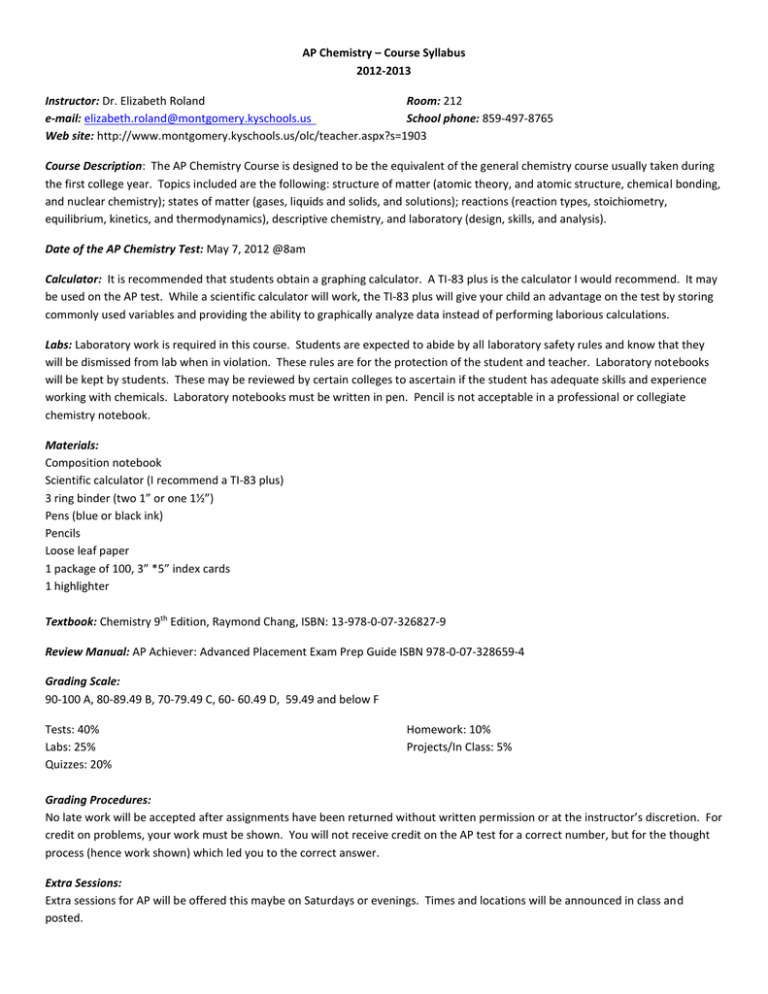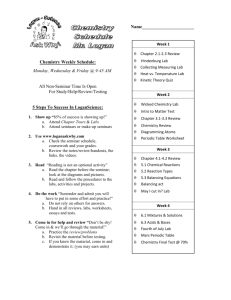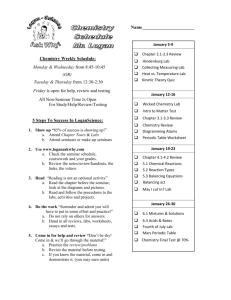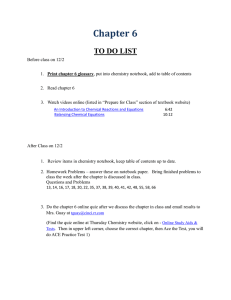AP Chemistry – Course Syllabus 2012-2013 Instructor: Dr. Elizabeth
advertisement

AP Chemistry – Course Syllabus 2012-2013 Instructor: Dr. Elizabeth Roland Room: 212 e-mail: elizabeth.roland@montgomery.kyschools.us School phone: 859-497-8765 Web site: http://www.montgomery.kyschools.us/olc/teacher.aspx?s=1903 Course Description: The AP Chemistry Course is designed to be the equivalent of the general chemistry course usually taken during the first college year. Topics included are the following: structure of matter (atomic theory, and atomic structure, chemical bonding, and nuclear chemistry); states of matter (gases, liquids and solids, and solutions); reactions (reaction types, stoichiometry, equilibrium, kinetics, and thermodynamics), descriptive chemistry, and laboratory (design, skills, and analysis). Date of the AP Chemistry Test: May 7, 2012 @8am Calculator: It is recommended that students obtain a graphing calculator. A TI-83 plus is the calculator I would recommend. It may be used on the AP test. While a scientific calculator will work, the TI-83 plus will give your child an advantage on the test by storing commonly used variables and providing the ability to graphically analyze data instead of performing laborious calculations. Labs: Laboratory work is required in this course. Students are expected to abide by all laboratory safety rules and know that they will be dismissed from lab when in violation. These rules are for the protection of the student and teacher. Laboratory notebooks will be kept by students. These may be reviewed by certain colleges to ascertain if the student has adequate skills and experience working with chemicals. Laboratory notebooks must be written in pen. Pencil is not acceptable in a professional or collegiate chemistry notebook. Materials: Composition notebook Scientific calculator (I recommend a TI-83 plus) 3 ring binder (two 1” or one 1½”) Pens (blue or black ink) Pencils Loose leaf paper 1 package of 100, 3” *5” index cards 1 highlighter Textbook: Chemistry 9th Edition, Raymond Chang, ISBN: 13-978-0-07-326827-9 Review Manual: AP Achiever: Advanced Placement Exam Prep Guide ISBN 978-0-07-328659-4 Grading Scale: 90-100 A, 80-89.49 B, 70-79.49 C, 60- 60.49 D, 59.49 and below F Tests: 40% Labs: 25% Quizzes: 20% Homework: 10% Projects/In Class: 5% Grading Procedures: No late work will be accepted after assignments have been returned without written permission or at the instructor’s discretion. For credit on problems, your work must be shown. You will not receive credit on the AP test for a correct number, but for the thought process (hence work shown) which led you to the correct answer. Extra Sessions: Extra sessions for AP will be offered this maybe on Saturdays or evenings. Times and locations will be announced in class and posted. Class Rules: 1. Unless permission is granted, no student should be in the laboratory section of the room. 2. Be prepared for class. 3. Be respectful of all members of the class and visitors. 4. Be academically honest. 5. We all have our own space, respect it. Lab Rules: 1. Must be properly attired to participate in lab. 2. Must have a signed safety contract by yourself and parent/guardian on file. 3. Must pass a safety prior to participation in the lab. 4. Not following any safety rules may lead to dismissal from lab and a zero for that laboratory experience. 5. Lab is not a right, it is a privilege. 6. Be prepared for lab having read the instructions and/or have laboratory procedure approved by the teacher. Lab Reports: All laboratory data must be recorded in composition notebooks. Use pen only. Some formal laboratory report will be turned in typed. After grading, they will be added to your composition notebook. Inquiry procedures will be clearly written in your laboratory notebook; any adjustments to procedures must be noted as well as approved by the teacher. Absences: Not all labs may be made up because not all solutions may be sorted for long periods of time or at all. Labs for make-up will occur after school and must be arranged in advance with the teacher. You must bring another student from class (AP sections) so as not to work alone (teacher will be present to monitor for safety). This policy mirrors most chemistry laboratories which require at least two working in a lab. Missed tests must be made-up within two weeks of absence. Make-up tests may be completely different from in class tests. Late homework will not be accepted after it is returned to class. Food and Drinks: No food or drinks are permitted in the laboratory portion of the room. Students in the lecture portion of the room may have covered drinks, but not food. This is a working laboratory and food is not permitted. Any food in the room is considered contaminated and will be labeled “unfit for human consumption.” Tips: 1. 2. 3. 4. 5. 6. 7. Discover how you learn best Review your notes daily, ask questions about your notes, do not cram (it really does not work) Make sure you have adequate sleep (sleeping helps your retain what you have studied) Ask questions of yourself, and Look for answers yourself (and with a little help) Do not trust googled answers Read your text as a consumer not as a window shopper Do not be afraid to be wrong, everyone is wrong sometimes Note on Course Outline: All information is tentative and subject to change based upon teacher’s professional knowledge. Additional problems and time may be added to units which will be determined by performance upon formative assessments administered. Topic Chapter/Section Labs Graphing, Safety, Significant Figures, Math Atomic Structure Chapter 1, read pages 4-7, 11-13 and 15-30 Labquest Measurements Lab Chapter 2, read pages 42-50, 53-54 Chapter 7, read pages 267- 302 Emission Spectra Lab Periodicity Chapter 2, read pages 50-51 Chapter 8, read pages 315-347 Trends and Predictions Lab Bonding, Molecules and Compounds Chapter 2, read pages 53- 68 Chapter 9, read pages 357-360 and 366-385 Chapter 10, read pages 400-437 Chapter 11, read pages 453-469, and 479-489 Identification of an unknown (cation and anion) Lab, Molecular Modeling Lab, Formula of Copper Chloride Hydrate Lab, Drops on a Penny Lab Stoichiometry and Solutions Chapter 3, read pages 97-106 Chapter 4, read pages 120-122, and 142-150 Gas Laws and Kinetic Molecular Theory Solutions and Colligative Properties Reactions: Acid/Base Chapter 5, read pages 170-208 Actual vs. Experimental Lab, Limiting Reagent Lab, How and What Hydrate Lab, Standard Solution Lab Analysis of Alka-Seltzer Lab Chapter 12, read pages 504-533 Oscillating Lab, Boiling Point Elevation Lab Chapter 4, read pages 127-131 and 150-152 Chapter 15, read pages 645 – 686 Strong and Weak Titrations Lab, What Indicator Works Lab Reactions: Precipitation/Redox Chapter 4, read pages 122-127, 131-142, and 153-155 Thermodynamics Chapter 6, read pages 224-254 Chapter 9, read pages 385-389 Chapter 18, read pages 784-809 Solubility Lab, Net Ionic Equations Lab, Progressive Precipitation Lab Mg in HCl Lab Equilibrium Chapter 14, read pages 546-588 Chapter 16, read pages 698-739 Kinetics Chapter 13, read pages 546-588 Crystal Violet Lab Electrochemistry Nuclear Chemistry Organic Chemistry Chapter 19, read pages 820-854 Chapter 23: read 968-994 Chapter 24, read 1004- 1029 Ice Cube Tray Half Reaction Lab Simulated Half-life Lab Synthesis and Purification of Salicylic Acid Review for AP Exam Problems Expected Time Chapter 1 3, 13, 17, 21, 22, 31, 33, 34, 38, 55 and graphing project Chapter 2: 10, 15, 18, 36, and 65 Chapter 7: 8, 10, 16, 20, 22, 28, 30, 48, 56, 59, 72, 76, 89, 114, and 124 Chapter 8: 4, 5, 13, 21, 31, 34, 35, 43, 51, 69, 81, and 133 Chapter 2: 33, 37, 43, 45, 51, and 69 Chapter 9: 5, 6, 17, 29, 40, 43, 55, 57, and 65 Chapter 10: 1, 3, 9, 13, 16, 29, 31, 38, 43, 45, and 53 Chapter 11: 2, 5, 6, 10, 16, 27, 61, 68, 93 1 week, with safety and lab skills on going Chapter 3: 13, 14, 15, 16, 19, 20, 21, 24, 28, 40, 44, 46, 50, 57, 59a-f, 63, 68, 74, 81, 86, 91, and 96 Chapter 4: 1, 9, 12, 61, 64, 72, 74, and 103 3 weeks Chapter 5: 14, 16, 17, 20, 22, 32, 36, 46, 52, 60, 63, 78, 85, and 88 Chapter 12: 3, 7, 10, 16, 19, 24, 28, 36, 39, 52, 54, 62, 64, 71, 76, 87, and 94 Chapter 4: 4, 27, 30, 31, 86, 88 and 106 Chapter 15: 5, 14, 18, 20, 23, 27, 30, 33, 40, 44, 46, 54, 62, 76, 80, 91 Chapter 4: 17, 19, 20 22, 34, 49, 92 and 94 2 weeks Chapter 6: 2, 11, 16, 26, 30, 34, 36, 45, 52, 54, and 74 Chapter 9: 70 and 88 Chapter 18: 5, 12, 13, 18, 24, 43, and 60 Chapter 14: 2, 6, 8, 16, 18, 20, 28, 40, 44, 60 and 62 Chapter 16: 3, 6, 7, 8, 12, 14, 22, 24, 28, 32, 33, 41, 43, 46, 50, 52, 58, 63, and 80 Chapter 13: 1, 6, 8, 9, 10, 16, 18, 28, 30, 33, 40, 47, 54, 55, 68, 84, and 92 Chapter 19: 2, 5, 6, 16, 17, 18, 22, 30, 46 and 52 Chapter 23: 3, 5, 10, 14, 18, 20, 26, 28, 33, 56, and 68 Chapter 24: 3, 11, 13, 26, 27, 31, 35, 36, and 59 3 weeks 2 weeks 2 weeks 3 weeks 2 weeks 2 weeks 2 weeks 3 weeks 3 weeks 3 weeks 1 week 1 week 2 Weeks



